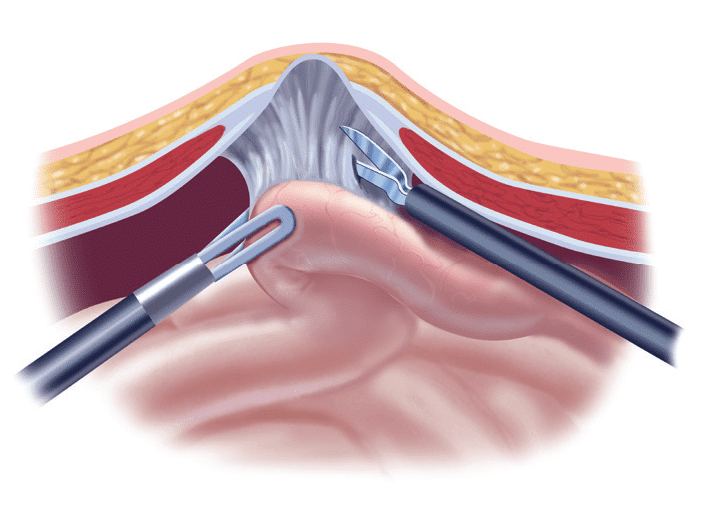Second Medical Opinion
Trust & Confidence
+91 8150000200
Book Appointment
Mon - Sat: 9:00 - 20:30
Appointment timing
Trust & Confidence
Book Appointment
Appointment timing
Diagnostic Laparoscopy is generally performed under general anesthesia but can also be performed under local anesthesia in certain cases. The surgeon and anesthetist will discuss with you the type of anesthesia will be safer and more comfortable for you. Local anesthesia is usually injected into the affected organ. For, e.g., if it is an abdominal condition, local anesthesia will be given into the skin of the abdominal wall. The drug will numb the entire region to enable painless incision and safe insertion of the laparoscope. Patients just feel a ‘bee sting’ before small doses of sedatives are administered intravenously. This puts the patient into what is referred to as ‘twilight sleep’, a state in which they are asleep but not in deep slumber.
Once the patient falls into the required depth of sleep, gas is released into the abdominal cavity to enlarge it in order for the surgeon to get a better view of the internal proceedings. The common gases are a nitrous oxide or laughing gas or carbon dioxide. There is little risk of ill-effects of the gas, which is removed from the abdomen after the operation.
Diagnostic laparoscopy is performed under general anesthesia if the patient is ineligible for surgery under ‘twilight sleep’ or for those who opt for it. General anesthesia is usually preferable for patients who are young, those who are unable to lie still or are afflicted with a medical condition, which makes general anesthesia a safer option

Pre-Laparoscopy Preparations
Most of the diagnostic laparoscopy is performed as outpatient procedures, meaning you can go home on the day of the procedure itself. You will not be allowed to eat or drink for a period of time before the laparoscopy, the duration of which will be decided by the surgeon and anesthesiologist.
Patients are required to arrive 1-2 hours before the scheduled laparoscopy. They will undergo certain tests like a blood test, urine analysis or x-ray before the procedure. You can shower on the morning of the procedure or on the night before.
Patients who take regular medication should discuss them with the doctor at the time of scheduling the procedure. The surgeon may disallow you take some of them immediately prior to the procedure. If you are on non-critical drugs like aspirin, blood thinners, arthritis medicine, the doctor will tell you when to stop taking them before the laparoscopy.
If you have been operated upon under sedatives, you will someone to drive you home after the procedure. Sedatives affect your reflexes and judgment for as much as 12-20 hours. You will not be allowed to drive any vehicle, even a two-wheeler until the following day.
The Procedure
The patient is either given local anesthesia and sedation or general anesthesia, after which the patient goes to sleep. The surgeon makes small incisions on the organ and inserts a narrow, tube-like instrument called a port inside the cavity. The laparoscope is a tiny telescope, which is connected to a camera, is then inserted through the port. The camera then provides a magnified view of the patient’s interior body parts on a television screen.
Other ports are inserted through the other incisions made, which give your surgeon the details and exact nature of your condition. This allows him or her to make a proper diagnosis and formulate the best treatment plan. After this, the surgeon removes all the instruments from the body and closes the incisions with sutures, which will be absorbed by the body or with surgical tapes.
After the Laparoscopy
Patients are transferred to a recovery room after the procedure where they are continuously monitored. The sedatives and anesthesia will take some time to wear off, even after patients are fully awake. You will be discharged once the effects of the drug have worn off enough to let you get out of bed and walk without assistance. As mentioned above, you must have someone to drive you home.
Expect some soreness around the incisions for some time. The pain will gradually subside, even as you take pain relievers. Most of the patients will be able to shower the next day after the laparoscopy, though you may need to cover the incision site with a plastic cover to prevent it from coming into contact with water. Patients generally return to their normal activities within a week. The surgeon will inform you in case there are certain restrictions in your case.
A follow-up examination is mandatory two weeks after the laparoscopy.
Possible Complications
Medical and surgical procedures can be prone to complications, the most common being infection and bleeding. After a laparoscopy, other complications that can arise, but are not limited to, include injury to the site and neighboring organs. Patients suffering from ascites may experience temporary leakage.
Consult your Doctor Immediately If:
Your condition reaches any of the following:
Dr. Manas Ranjan Tripathy has achieved acclaim in proctology. His areas of expertise are sophisticated minimally invasive laser surgeries for Hemorrhoids or piles, anal fissures, anal fistulas with special expertise in laser Hemorrhoidopexy and recurrent and complex fistulas.